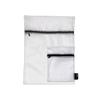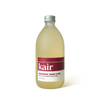How to care for your cashmere at home
With autumn well on its way, and the nights beginning to draw in, it’s the perfect time to get out your cosy cashmere pieces, whether that be jumpers, cardigans, scarves or even shawls. Though washing cashmere at home may seem a bit daunting, with the right tender, loving Kair, it can be done with joy. Read on to discover our top tips for keeping your cashmere in perfect condition, so that both you and your favourite garments can be sure to survive the cold months ahead.
Washing
You can wash cashmere both by machine and, for delicate pieces which are embellished, embroidered, beaded or sequined, by hand. As cashmere is one of the most delicate fabrics, with very fragile and easy-to-damage fibres, hand washing is always the safest and gentlest option (check out our blog post on hand washing for a full step-by-step guide). Choose only the very gentlest of detergents (we recommend our Wool, Silk and Delicates Wash) and dissolve completely in cold water (no more than 30ºC). Once submerged, gently rock before giving it a squeeze until the water runs clear. Don’t twist or wring, as this can damage the fibres and alter the shape of the garment. When it comes to machine washing, again choose a gentle detergent and cool wash with a low spin, and be sure to use a mesh laundry bag.
Drying

Image by Paul Engel
Avoid tumble dryers, and direct heat sources like sunlight or radiators, at all costs, as these can damage and shrink the fibres. Instead turn your cashmere inside out and lay it flat on a clean towel, then ease it back into its natural shape. Once dry, steam lightly with a cool iron, before releasing wrinkles with our Signature Finishing Spray.
Storage
If you want your cashmere to live on and on, don’t wash it after every wash. It can comfortably go wash-free for 7-10 wears! Be careful when storing it too: if you hang it, the shoulders will likely become misshapen, so, instead, fold your pieces and store them in a dresser or on a wardrobe shelf. If you’re putting it away for the summer, pop it in an airtight container (be sure to avoid cardboard boxes, which larvae will simply chew through). Be sure to regularly spritz with some of our Signature Finishing Spray, too, to lock in scent and infuse your cashmere with lasting freshness all year round.
Moths
Clothes moths are bad news for your cashmere: their eggs can cause catastrophic damage to the natural fibres. Keep them at bay by keeping both your cashmere and wardrobe clean, and use natural sweet-scented deterrents such as hanging sachets of lavender, rosemary or clove. Avoid letting cedarwood blocks or chips come into direct contact with your cashmere, as these can transfer oil onto the fabrics and stain them. Instead, wash with our Wool, Silk and Delicates Wash - the cedarwood, amber and iris scent is a natural moth repellent. If you’ve already got moths, simply pop your cashmere pieces in a plastic bag, freeze them for a day or overnight, then slowly defrost them. It sounds crazy, but it works!
Pilling

Image by @askcharliehow
‘Pills’ are simply little bobbles which form on the surface of cashmere garments as some of the very fine fibres become loose and tangle together. It’s a natural consequence of the friction of wear, and certainly not indicative of the poor quality of your garment! In fact, careful removal of pills will actually allow your garment to consolidate and further soften. Remove pills either by hand or by using a special cashmere comb (we particularly love this one by Catherine Robinson), making sure to lay your knitwear flat and taut as you work through the fibres.
Cover image by Huffpost




















